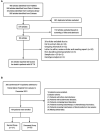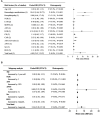A model based on meta-analysis to evaluate poor prognosis of patients with severe fever with thrombocytopenia syndrome
- PMID: 38260897
- PMCID: PMC10801726
- DOI: 10.3389/fmicb.2023.1307960
A model based on meta-analysis to evaluate poor prognosis of patients with severe fever with thrombocytopenia syndrome
Abstract
Background: Early identification of risk factors associated with poor prognosis in Severe fever with thrombocytopenia syndrome (SFTS) patients is crucial to improving patient survival.
Method: Retrieve literature related to fatal risk factors in SFTS patients in the database, extract the risk factors and corresponding RRs and 95% CIs, and merge them. Statistically significant factors were included in the model, and stratified and assigned a corresponding score. Finally, a validation cohort from Yantai Qishan Hospital in 2021 was used to verify its predictive ability.
Result: A total of 24 articles were included in the meta-analysis. The model includes six risk factors: age, hemorrhagic manifestations, encephalopathy, Scr and BUN. The analysis of lasso regression and multivariate logistic regression shows that model score is an independent risk factor (OR = 1.032, 95% CI 1.002-1.063, p = 0.034). The model had an area under the curve (AUC) of 0.779 (95% CI 0.669-0.889, P<0.001). The validation cohort was divided into four risk groups with cut-off values. Compared with the low-medium risk group, the mortality rate of high-risk and very high-risk patients was more significant (RR =5.677, 95% CI 4.961-6.496, P<0.001).
Conclusion: The prediction model for the fatal outcome of SFTS patients has shown positive outcomes.Systematic review registration:https://www.crd.york.ac.uk/prospero/ (CRD42023453157).
Keywords: SFTS; cohort study; meta-analysis; prediction model; risk factors.
Copyright © 2024 Liu, Jiang, Zhang, Xue, Zhao, Xu, Zhang, Lin and Chen.
Conflict of interest statement
The authors declare that the research was conducted in the absence of any commercial or financial relationships that could be construed as a potential conflict of interest.
Figures




Similar articles
-
Biomarkers for Early Predicting In-Hospital Mortality in Severe Fever with Thrombocytopenia Syndrome and Differentiating It from Hemorrhagic Fever with Renal Syndrome.Infect Drug Resist. 2025 Mar 12;18:1355-1366. doi: 10.2147/IDR.S492942. eCollection 2025. Infect Drug Resist. 2025. PMID: 40092848 Free PMC article.
-
Novel nomograms to predict risk and prognosis in hospitalized patients with severe fever with thrombocytopenia syndrome.Front Med (Lausanne). 2023 Dec 1;10:1321490. doi: 10.3389/fmed.2023.1321490. eCollection 2023. Front Med (Lausanne). 2023. PMID: 38105896 Free PMC article.
-
Risk factors of severe fever with thrombocytopenia syndrome combined with central neurological complications: A five-year retrospective case-control study.Front Microbiol. 2022 Nov 3;13:1033946. doi: 10.3389/fmicb.2022.1033946. eCollection 2022. Front Microbiol. 2022. PMID: 36406394 Free PMC article.
-
Severe fever with thrombocytopenia syndrome: a systematic review and meta-analysis of epidemiology, clinical signs, routine laboratory diagnosis, risk factors, and outcomes.BMC Infect Dis. 2020 Aug 5;20(1):575. doi: 10.1186/s12879-020-05303-0. BMC Infect Dis. 2020. PMID: 32758175 Free PMC article.
-
Clinical symptoms associated with fatality of severe fever with thrombocytopenia syndrome: A systematic review and meta-analysis.Acta Trop. 2022 Aug;232:106481. doi: 10.1016/j.actatropica.2022.106481. Epub 2022 Apr 21. Acta Trop. 2022. PMID: 35461803
Cited by
-
Retrospective Analysis of Severe Fever With Thrombocytopenia Syndrome and Construction of a Nomogram Prediction Model for Mortality Risk Factors.Open Forum Infect Dis. 2025 Jun 2;12(7):ofaf318. doi: 10.1093/ofid/ofaf318. eCollection 2025 Jul. Open Forum Infect Dis. 2025. PMID: 40599492 Free PMC article.
-
Machine learning for identifying risk of death in patients with severe fever with thrombocytopenia syndrome.Front Microbiol. 2024 Sep 13;15:1458670. doi: 10.3389/fmicb.2024.1458670. eCollection 2024. Front Microbiol. 2024. PMID: 39345257 Free PMC article.
-
Metabolic Profiling Reveals Potential Prognostic Biomarkers for SFTS: Insights into Disease Severity and Clinical Outcomes.Metabolites. 2025 Mar 27;15(4):228. doi: 10.3390/metabo15040228. Metabolites. 2025. PMID: 40278357 Free PMC article.
-
Aspartate aminotransferase to platelet ratio correlates with poor prognosis and metabolic alterations in Dabie bandavirus infection.Front Immunol. 2025 Jan 17;15:1471511. doi: 10.3389/fimmu.2024.1471511. eCollection 2024. Front Immunol. 2025. PMID: 39896801 Free PMC article.
-
A multicenter study on developing a prognostic model for severe fever with thrombocytopenia syndrome using machine learning.Front Microbiol. 2025 Mar 19;16:1557922. doi: 10.3389/fmicb.2025.1557922. eCollection 2025. Front Microbiol. 2025. PMID: 40177493 Free PMC article.
References
-
- General Office of the Ministry of Health of the People’s Republic of China (2010) Notice on Issuing Guidelines for the Prevention and Treatment of Fever with Thrombocytopenia Syndrome (2010 Edition). Available at: https://www.gov.cn/gzdt/2010-10/09/content_1718261.htm (Accessed August 9, 2023).
Publication types
LinkOut - more resources
Full Text Sources

